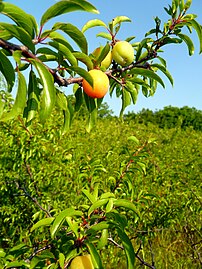Prunus angustifolia
| Prunus angustifolia | |
|---|---|

| |
| Scientific classification | |
| Kingdom: | Plantae |
| Clade: | Tracheophytes |
| Clade: | Angiosperms |
| Clade: | Eudicots |
| Clade: | Rosids |
| Order: | Rosales |
| Family: | Rosaceae |
| Genus: | Prunus |
| Subgenus: | Prunus subg. Prunus |
| Section: | Prunus sect. Prunocerasus |
| Species: | P. angustifolia
|
| Binomial name | |
| Prunus angustifolia | |

| |
| Natural range of Prunus angustifolia | |
| Synonyms[2] | |
| |
Prunus angustifolia, known commonly as Chickasaw plum, Cherokee plum, Florida sand plum, sandhill plum, or sand plum,[3] is a North American species of plum-bearing tree. It was originally cultivated by Native Americans before the arrival of Europeans.[4][5][6] The species' name angustifolia refers to its narrow leaves. It became the official state fruit of Kansas in 2022.[7]
Description[edit]
Chickasaw plum grows 3.7 to 6.1 meters (12 to 20 feet) tall and 4.6 to 6.1 m (15 to 20 ft) wide in an irregular shape. It is "twiggy" in nature, and has a scaly, almost black bark. Its branches are reddish with thorn-like, small side branches. In February, March, April and May, small white flowers blossom, 8–10 millimeters (5⁄16–3⁄8 inch) wide, along with red plums, up to 25 mm (1 in) long. The flowers have five white petals with reddish or orange anthers. The plums are cherry-like and tend to be quite tart until they fully ripen.[8] They ripen in late summer. It requires low to medium amounts of water to grow, and dry, sandy or loose soil. It grows best in areas with regular sunlight or areas of partial shade. In sunny areas, it will be more dense and colonize thickly. In areas of partial shade, it will be thinner and less dense, and each plant will be more spread out.[citation needed]
P. angustifolia is very difficult to distinguish from P. umbellata, with which it hybridizes easily.[9]
Taxonomy[edit]
American plum (Prunus americana Marsh.) hybridizes naturally with P. angustifolia to produce P. × orthosepala Koehne.[10]
Distribution and habitat[edit]
P. angustifolia is widespread across much of the eastern and central United States from Florida west as far as New Mexico and California, north to Nebraska, Illinois, and New Jersey, with a few isolated populations in northern Michigan.[11] The species grows in dry and sandy soils, such as open woodlands, woodland edges, forest openings, savannahs, prairies, plains, meadows, pastures, and roadsides. It is listed by the U.S. Department of Agriculture as an endangered species in the state of New Jersey.[citation needed]
Ecology[edit]
It is used by many species as a larval host, including the black-waved flannel moth, the blinded sphinx, the cecropia moth, the coral hairstreak, the elm sphinx, the hummingbird clearwing moth, the imperial moth, the Io moth, the polyphemus moth, the promethea silkmoth, the red-spotted purple, the small-eyed sphinx, the spring azure, the striped hairstreak, and the tiger swallowtail.[12]
The fruit is eaten by various animals, and the foliage provides cover for nesting sites.[citation needed]
Uses[edit]
Chickasaw plums tend to bloom early in the spring before many other plants bloom, and require very little maintenance; as a result, they are often used in ornamental horticulture. They are often found growing wild along highways, especially in the southern U.S.
The 1⁄2-in. edible fruits change from yellow to red when fully ripe. They may be eaten raw and are often made into jellies.[13] Because of its attractive bark, small leaves and thin branches, Chickasaw plum is also sometimes used for bonsai.[13]
References[edit]
- ^ Pollard, R.P.; Rhodes, L.; Maxted, N. (2016). "Prunus angustifolia". IUCN Red List of Threatened Species. 2016: e.T50673310A50673313. doi:10.2305/IUCN.UK.2016-3.RLTS.T50673310A50673313.en. Retrieved 20 November 2021.
- ^ "The Plant List: A Working List of All Plant Species". Retrieved January 27, 2014.
- ^ "Prunus angustifolia". Germplasm Resources Information Network. Agricultural Research Service, United States Department of Agriculture. Retrieved 12 January 2018.
- ^ Bartram, W. Travels through North and South Carolina, Georgia, East and West Florida. 1791.
- ^ Sargent, C. S. Manual of the trees of North America. 2nd Ed. Vol. II. Dover Pub., Inc. New York. 934p. 1965.
- ^ Little, E. L. Checklist of United States Trees. USDA Forest service. Washington, D.C. 1979.
- ^ Taborda, Noah (April 12, 2022). "Sandhill plum officially named Kansas state fruit". Reflector. Retrieved April 12, 2022.
- ^ Boning, Charles R. (2006). Florida's Best Fruiting Plants: Native and Exotic Trees, Shrubs, and Vines. Sarasota, Florida: Pineapple Press, Inc. p. 77. ISBN 1561643726.
- ^ "Plum Delicious and Native, Too!". Florida Native Plant Society. July 15, 2011. Retrieved December 28, 2014.
- ^ Lee, Sangtae; Wen, Jun. (2001). A phylogenetic analysis of Prunus and the Amygdaloideae (Rosaceae) using ITS sequences of nuclear ribosomal DNA. American Journal of Botany. 88(1): 150-160.
- ^ Biota of North America Program 2014 county distribution map
- ^ The Xerces Society (2016), Gardening for Butterflies: How You Can Attract and Protect Beautiful, Beneficial Insects, Timber Press.
- ^ a b Edward F. Gilman and Dennis G. Watson. "Prunus angustifolia: Chickasaw Plum". University of Florida. Retrieved 3 May 2011.
External links[edit]
- "Prunus angustifolia". Plants for a Future.
- "Prunus angustifolia watsonii". Plants for a Future.
- Oklahoma Biological Survey
- USDA Prunus Angustifolia
- Virginia Tech Department of Forest Resources and Environmental Conservation
- Floridata Prunus Angustifolia
- The University of Texas at Austin Lady Bird Johnson Wildflower Center
- Kansas Forest Service
They grow around Beaver County Oklahoma and Lipscomb county Texas




